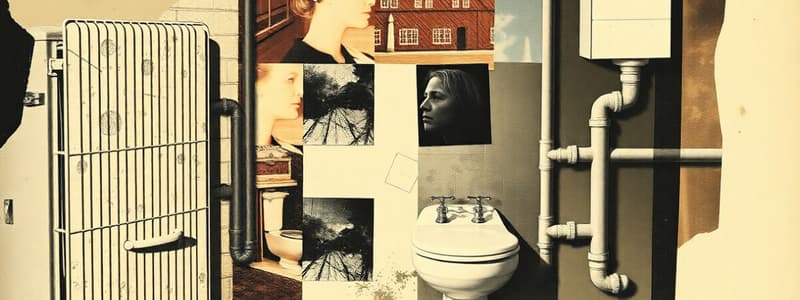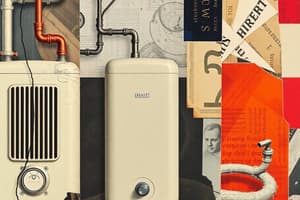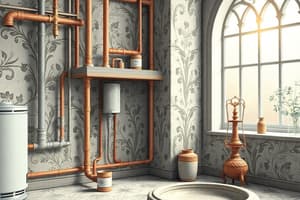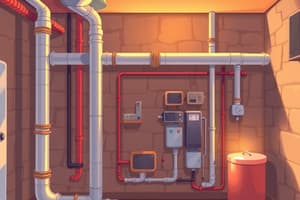Podcast
Questions and Answers
In an open vented central heating system, what is the primary function of the feed and expansion (F&E) cistern?
In an open vented central heating system, what is the primary function of the feed and expansion (F&E) cistern?
- To increase the pressure of the water in the system.
- To filter the water entering the system.
- To allow heated water to expand and to operate at atmospheric pressure. (correct)
- To cool the water before it is circulated.
Why should the open vent pipe in a central heating system be free of any valves?
Why should the open vent pipe in a central heating system be free of any valves?
- To comply with building regulations.
- To prevent disastrous effects such as over-pressurization if the valve is closed and cold feed becomes blocked. (correct)
- To prevent unauthorized adjustments to the system’s pressure.
- To ensure the system can be easily drained for maintenance.
What is the main purpose of an air separator in a central heating system?
What is the main purpose of an air separator in a central heating system?
- To increase the water pressure within the system.
- To remove air from the system, reducing noise and the risk of corrosion. (correct)
- To regulate the flow of water to different zones in the system.
- To reduce the temperature of the water before it reaches the radiators.
In an H frame configuration for central heating pipework, what is the significance of the 150mm maximum distance?
In an H frame configuration for central heating pipework, what is the significance of the 150mm maximum distance?
Why is it important to position the central heating pump to draw on the cold feed?
Why is it important to position the central heating pump to draw on the cold feed?
What typically maintains the watertight seal of a circulator located in position by pump flanges?
What typically maintains the watertight seal of a circulator located in position by pump flanges?
What is the purpose of the full bore valves installed on either side of a central heating pump?
What is the purpose of the full bore valves installed on either side of a central heating pump?
Why is the position of the circulator relative to the cold feed and vent pipe important?
Why is the position of the circulator relative to the cold feed and vent pipe important?
How does a two-port motorized valve, commonly known as a zone valve, function in a central heating system?
How does a two-port motorized valve, commonly known as a zone valve, function in a central heating system?
In a three-port mid-position valve, what is the function of the valve when it is in the mid-position?
In a three-port mid-position valve, what is the function of the valve when it is in the mid-position?
Where is a cylinder thermostat typically situated on a hot water cylinder, and what is its primary function?
Where is a cylinder thermostat typically situated on a hot water cylinder, and what is its primary function?
When installing a room thermostat, what placement guidelines should be followed to ensure accurate temperature readings?
When installing a room thermostat, what placement guidelines should be followed to ensure accurate temperature readings?
What is the function of a boiler thermostat?
What is the function of a boiler thermostat?
What feature do programmers often include to allow temporary operation outside of the set schedule?
What feature do programmers often include to allow temporary operation outside of the set schedule?
How do frost and pipe thermostats protect a central heating system during cold weather?
How do frost and pipe thermostats protect a central heating system during cold weather?
When working on a domestic central heating system, what safety precaution should be taken regarding the electrical supply?
When working on a domestic central heating system, what safety precaution should be taken regarding the electrical supply?
What is the primary function of a magnetic system cleaner in a central heating system?
What is the primary function of a magnetic system cleaner in a central heating system?
How do chemical inhibitors protect a central heating system?
How do chemical inhibitors protect a central heating system?
What is the purpose of a lock shield valve on a radiator?
What is the purpose of a lock shield valve on a radiator?
Why is balancing a central heating system important?
Why is balancing a central heating system important?
During the process of balancing a central heating system, what is the initial position for all wheel head valves on the radiators?
During the process of balancing a central heating system, what is the initial position for all wheel head valves on the radiators?
What tool is commonly used to bleed air from a radiator?
What tool is commonly used to bleed air from a radiator?
What function does PTFE tape serve when making up a radiator?
What function does PTFE tape serve when making up a radiator?
What part do Building Regulations part L and the Heating Compliance Guide require to be fitted on systems?
What part do Building Regulations part L and the Heating Compliance Guide require to be fitted on systems?
If a radiator with a TRV is removed for decorating, what is important to fit over the head to the valve?
If a radiator with a TRV is removed for decorating, what is important to fit over the head to the valve?
What can be fitted with remote sensors, which allow the TRV to operate if long curtains or other furniture could interfere with the operation of the phial?
What can be fitted with remote sensors, which allow the TRV to operate if long curtains or other furniture could interfere with the operation of the phial?
What is the function of an automatic bypass valve (ABV) in a modern central heating system?
What is the function of an automatic bypass valve (ABV) in a modern central heating system?
Where should an ABV be fitted?
Where should an ABV be fitted?
What type of connection is a filling loop, and on what systems is it typically used?
What type of connection is a filling loop, and on what systems is it typically used?
What is a requirement of The Water Regulations regarding filling loops?
What is a requirement of The Water Regulations regarding filling loops?
What is the main purpose of an expansion vessel in a sealed heating system?
What is the main purpose of an expansion vessel in a sealed heating system?
What pressure are expansion vessels charged to on the dry side?
What pressure are expansion vessels charged to on the dry side?
What is the function of a pressure relief valve (PRV) in a sealed central heating system?
What is the function of a pressure relief valve (PRV) in a sealed central heating system?
What is a common cause of a pressure build-up that requires the system needs to discharge excess pressure?
What is a common cause of a pressure build-up that requires the system needs to discharge excess pressure?
Where are automatic air release valves typically fitted in a central heating system, and what is their function?
Where are automatic air release valves typically fitted in a central heating system, and what is their function?
Where can air be released from inside a central heating system?
Where can air be released from inside a central heating system?
What part of the automatic air release valve allows it to automatically release any air?
What part of the automatic air release valve allows it to automatically release any air?
Why is it important to position the base of the Feed and Expansion (F&E) cistern at the same level as the cold water storage cistern?
Why is it important to position the base of the Feed and Expansion (F&E) cistern at the same level as the cold water storage cistern?
Considering the function of the open vent pipe, what could be a potential consequence of a closed valve on this pipe?
Considering the function of the open vent pipe, what could be a potential consequence of a closed valve on this pipe?
What is the purpose of the 'Float Operated Valve (FOV)' within the F&E cistern?
What is the purpose of the 'Float Operated Valve (FOV)' within the F&E cistern?
In a central heating system employing an H frame configuration, why must the vent and cold feed connections be situated on the flow from the boiler, specifically on the suction side of the circulator?
In a central heating system employing an H frame configuration, why must the vent and cold feed connections be situated on the flow from the boiler, specifically on the suction side of the circulator?
How does the positioning of the circulator relative to the cold feed affect the system's performance?
How does the positioning of the circulator relative to the cold feed affect the system's performance?
What is the consequence of hot water being only lukewarm and the radiators not heating up fully?
What is the consequence of hot water being only lukewarm and the radiators not heating up fully?
In a central heating system using a three-port mid-position valve, what is the operational state when the valve is positioned to only supply hot water to the central heating circuit (port A)?
In a central heating system using a three-port mid-position valve, what is the operational state when the valve is positioned to only supply hot water to the central heating circuit (port A)?
Why do frost thermostats override other thermostat settings?
Why do frost thermostats override other thermostat settings?
Apart from switching off the fused spur, removing the fuse, and locking off the fuse holder, what is another crucial step in a safe isolation procedure?
Apart from switching off the fused spur, removing the fuse, and locking off the fuse holder, what is another crucial step in a safe isolation procedure?
During the process of balancing a central heating system, what specific adjustment is made using the lockshield valves on the radiators?
During the process of balancing a central heating system, what specific adjustment is made using the lockshield valves on the radiators?
Flashcards
Feed and Expansion Cistern
Feed and Expansion Cistern
An open-vented system component that fills the system with water. It accommodates water expansion due to heating and maintains atmospheric pressure.
Open Vent Pipe
Open Vent Pipe
A safety device that releases pressure in open vented central heating systems.
Float Operated Valve (FOV)
Float Operated Valve (FOV)
A valve that fills a cistern to a set level.
Air Separator
Air Separator
Signup and view all the flashcards
H-Frame Configuration
H-Frame Configuration
Signup and view all the flashcards
Circulator
Circulator
Signup and view all the flashcards
Two Port Motorised Valve
Two Port Motorised Valve
Signup and view all the flashcards
Three Port Mid-Position Valve
Three Port Mid-Position Valve
Signup and view all the flashcards
Cylinder Thermostat
Cylinder Thermostat
Signup and view all the flashcards
Room Thermostat
Room Thermostat
Signup and view all the flashcards
Boiler Thermostat
Boiler Thermostat
Signup and view all the flashcards
Programmer
Programmer
Signup and view all the flashcards
Frost Thermostat
Frost Thermostat
Signup and view all the flashcards
Magnetic System Cleaner
Magnetic System Cleaner
Signup and view all the flashcards
Inhibitor
Inhibitor
Signup and view all the flashcards
Radiator Valves
Radiator Valves
Signup and view all the flashcards
Balancing the System
Balancing the System
Signup and view all the flashcards
Radiator Key
Radiator Key
Signup and view all the flashcards
Bleed Key
Bleed Key
Signup and view all the flashcards
Thermostatic Radiator Valve
Thermostatic Radiator Valve
Signup and view all the flashcards
Automatic Bypass Valve
Automatic Bypass Valve
Signup and view all the flashcards
Filling Loop
Filling Loop
Signup and view all the flashcards
Expansion Vessel
Expansion Vessel
Signup and view all the flashcards
Pressure Relief Valve
Pressure Relief Valve
Signup and view all the flashcards
Automatic Air and Release Valve
Automatic Air and Release Valve
Signup and view all the flashcards
Study Notes
- The lesson aims to help learners identify central heating components.
- The purpose of a central heating pump, and its best location, will be examined.
- The internal mechanisms of a Feed & Expansion Cistern will be understood.
- Learners will understand the importance of balancing a central heating system and how to achieve it.
Open Vented System
- A feed and expansion cistern is used in open vented systems.
- It fills the system with water.
- Cisterns are located in the loft, at the system's highest point.
- F&E cistern bases should align with the cold water storage cistern and be fully supported.
- The main function of the F&E is to facilitate heated water expansion at atmospheric pressure.
- F&E cisterns are typically 18-litre, black plastic containers.
- A 15mm cold feed connects to the F&E side and must be free of valves.
- A 22mm open vent from the primaries is located above the F&E, rising at least 450mm above the water level without valves.
- F&E cisterns should be positioned at least 1 meter above the circulator.
Float Operated Valve (FOV)
- The rising main feeds the BS 1212 FOV in the F&E, preceded by a service valve for maintenance.
- The water level set by the FOV should barely cover the cold feed exit to allow for expansion.
- Heated system water expands by 4%, accommodated in the F&E.
Open Vent Pipe
- The main role of the open vent pipe is to serve as a safety outlet if the system overheats.
- This pipe allows the system to function at atmospheric pressure.
- The open vent enables air to escape while the system fills and operates.
- It must be free of valves to prevent potential blockage of the cold feed.
- The vent needs to be at least 450mm above the water level to prevent pump surge.
- The minimum pipe size is 22mm.
Air Separator
- An air separator enables close proximity or close-coupled pipework for the cold feed and vent pipes.
- The air separator is an oversized pipe with cold feed and vent pipe connections.
- It separates air by swirling water.
- Correct pipework and air removal reduce noise and the risk of corrosion in the system.
H Frame Configuration
- As an alternative to an air separator, an H frame configuration is commonly used.
- The vent and cold feed need to be installed on the flow from the boiler.
- Install it on the suction side of the circulator, with a maximum of 150mm between them
- Ensuring the circulator always draws on the cold feed.
- Correct pipework ensures the system's neutral point is at the cold feed base.
Circulator
- Pump positioning is crucial for positive pressure and to avoid air entering the system, preventing corrosion.
- The circulator must always draw on the cold feed.
- Circulators have speed settings to efficiently heat the system without noise.
- A circulator uses pump flanges to maintain a watertight seal via rubber or fibre washers.
- Full bore valves allow removal without draining the system.
- If radiators aren't heating and hot water is lukewarm, the pump may need replacing.
- Isolation valves are integral to the flanges for easy maintenance.
- The position of the circulator, relative to the cold feed and vent pipe, is important for positive pressure.
Two Port Motorised Valve
- Zone valves are activated by a room or cylinder thermostat.
- They enable separate control of hot water and heating circuits.
- The zone valve opens to allow water from the boiler to circulate. When the thermostat is up to temperature, the zone valve closes to isolate.
Three Port Mid-Position Valve
- These valves control water flow to both heating and hot water circuits, reacting to cylinder and room thermostats.
- Ports are labeled AB (flow from boiler), A (central heating), and B (hot water).
- In mid-position, the valve allows water to circulate around both heating A and hot water B circuits.
- In heating mode only, water is allowed to circulate around the central heating circuit (port A).
- In central heating mode only, water is allowed to circulate around the hot water circuit (port B).
- Water can always flow through this valve.
Cylinder Thermostat
- Cylinder thermostats are located one-third of the way up a hot water cylinder.
- The thermostat governs the hot water temperature.
- It's linked to the zone valve or three-port valve.
- These thermostats can be bi-metallic strip, volatile liquid, or gas type.
- They are commonly set to a maximum of 60°C.
Room Thermostat
- Room thermostats are located 1.5 meters up a wall and approximately 3 meters from a heat source, avoiding outside walls.
- They can be basic bi-metallic or programmable Wi-Fi/app-activated digital types.
- Compensating room thermostats are also common.
Boiler Thermostat
- Boiler thermostats are located on the boiler.
- They govern the temperature of the primary water.
- The water heats the heat exchanger in the hot water cylinder, as well as heating the heat emitters in each room.
- Boiler thermostats include a phial on the boiler's return pipe, indicating when the system is up to temperature.
Programmer
- Programmers allow independent, timed control of hot water and central heating.
- They are commonly situated in the kitchen or airing cupboard.
- These often include a boost or override button to operate outside programmed timings.
Frost Thermostat and Pipe Thermostat
- These thermostats prevent vulnerable parts of the system from freezing.
- They override the programmer and other thermostats, set between 3ºC and 5°C.
- Frost thermostats are positioned in vulnerable areas, and pipe thermostats.
- They activate the circulator and boiler briefly to warm the system water.
Working Safely
- When working on any electrical components, including the boiler, safe isolation procedure is vital to ensure no one accidentally turns on the system.
- This involves switching off the fused spur, removing the fuse, locking off the fuse holder, and putting up a sign indicating work is in progress.
- When working on a domestic system it needs to be communicated to the customer and other people in the property.
- Communication needs to cover how long it will be out of service for and also when decommissioning a system.
Magnetic System Cleaner
- Magnetic system cleaners, of various styles and makes, contain a magnet to collect corroded iron particles (magnetite).
- During system service, the magnet is removed to flush away the magnetite, keeping the system water in good condition.
Inhibitor
- Inhibitors chemically protect against scale and corrosion in central heating systems.
- They can be added via the F&E tank or a radiator.
- Inhibitor levels can be tested and topped up.
- Inhibitors are claimed to extend system life, maximizing efficiency and minimizing fuel usage.
- The primary vent must terminate over the F&E tank, due to the chemical content.
Radiator Valves
- Radiators fit at either end of a domestic radiator.
- One with a wheel head, which the customer can turn. This alters the flow of water into the radiator to suit the customer's needs.
- A lock shield valve is placed on the opposite end of the radiator.
- A lock shield is identical to wheel head, except it has a wheel removed.
- Lock shield caps are put in its place for the engineer to balance the system.
Balancing the System
- The lock shield valve balances the system during commissioning.
- Unbalanced systems cause non-uniform radiator warming and can affect the 10°C temperature difference between flow and return pipework.
- System water circulation faces resistance from pipework, fittings, and bends.
- Water takes the path of least resistance, so some radiators might heat up quicker and others may stay cool.
- Open wheel head valves fully on all radiators.
- Open all lock shield valves half way.
- Turn on the boiler, selecting both CH & HW.
- Take the temperature of all radiators to see if they are warming uniformly.
- If a radiator's is heating too much/little, adjust suits the lock shield to suit.
- Put the lock shield back on when they have achieved the same temperature.
Radiator Key
- Use PTFE tape, hemp, and paste for the watertight seal on the threads when making up a radiator.
- Valves are screwed into the radiator using a radiator key.
- TBOE = top bottom opposite ends.
- BBOE = bottom bottom opposite ends.
- A bleed key is needed to bleed any air or is from the radiator, it is used on the top of radiators.
Bleed Key
- An air release valve is located at the top of every radiator and towel rail.
- This allows manual release of air.
Thermostatic Radiator Valve
- Thermostatic Radiator Valves requires TRVs to be fitted on systems.
- This valve replaces the wheel head valve.
- It allows the customer to control the temperature of a single radiator
- It has a special head, which reacts to ambient air temperature.
- A sensor inside the head contains a volatile liquid when heated expands.
- The warmer the room's temperature, the closing of the valve of pushing a pin down in the valve.
- The room temperature cools, the liquid contracts, there by opening the valve again and allowing the radiator to heat back up.
- One radiator in the circuit must be left without a TRV fitted.
- Building Regulations state this should be the radiator in the same room as the room stat.
- If a radiator fitted with a TRV is removed for decorating, place a decorators cap over the head to the valve.
- If the customer has long curtains, remote heads should be installed.
- TRVs are mostly placed on the flow but it doesn't matter so be careful when fitting.
- Noise can occur if customer ends up with something noisy.
- These items can be fitted with remote sensors, allowing TRVs to operate despite interference from curtains or furniture.
Automatic Bypass Valve
- ABV is fitted on most Modern systems.
- Allows build up of systems if thermostatic radiator valves close.
- Circulator will continue to operate.
- Relieves through system pipe work which helps prolong pump life.
- ABV its between the primary flow and return pipe.
- Some boilers already have an ABV installed.
- This allows water to flow through the boiler if the TRVs and zone valves close.
Filling Loop
- This is a flexible, temporary connection between the incoming mains and the central heating system.
- It's used on pressurized sealed systems, like combination boilers.
- Water Regulations require it to be disconnected after use.
- There is a quarter-turn isolator on both sides of the loop.
- The incoming mains is protected by a double check valve, as Water Regulations require.
Expansion Vessel
- Used on a sealed system to take up the 4% expansion of the heated water.
- Sized depending on the system.
- A rubber diaphragm/bladder is located inside the vessel.
- On the drier side it is changed through a schrader valve with 1 Bar of pressure.
- Expanded water pushes against the diaphragm on the wet side to compress the air.
Pressure Relief Valve
- When a sealed system over-pressurises a PRV is installed (Pressure Relief Valve).
- Allowing the access pressure to discharge safely.
- Discharge Pressure is factory set.
- A build up of pressure can occur when the expansion vessel fails or loses its charge.
Automatic Air Release Valve
- Found fitted inside boilers as well as high points inside systems.
- Automatic Air Release Valves allow air to be released from systems and close automatically.
Studying That Suits You
Use AI to generate personalized quizzes and flashcards to suit your learning preferences.




